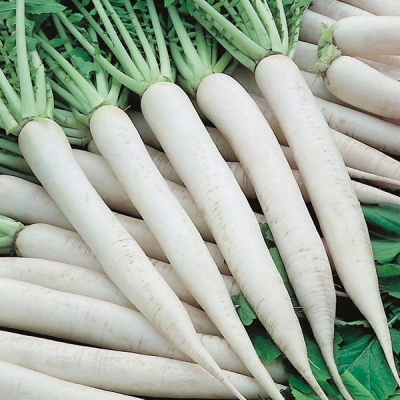Asiatic varieties
Japanese White: White roots, long, cylindrical, variety gets ready in 60 days. It is suitable for high and intermediate hilly areas. It gives an average yield of 83-104qtl/acre.
Chinese Pink: Pink roots, cylindrical, white flesh, red main stripes on long leaves; variety gets ready in 45 days. It is suitable for high and intermediate hilly areas. It gives an average yield of 83-104qtl/acre.
Pusa Chetki: Long roots, white and is suitable for summer season. It gives an average yield of 62.5-83qtl/acre.
European varieties
Pusa Himani: 30-35cm long, thick, sharp, round roots, light green color upper part and light white color lower part. The variety gets ready in 55-60 days. It is suitable for sowing in ground areas in December-February month and in intermediate and high hilly areas it is suitable for sowing in summer month. The variety gives an average yield of 94-105qtl/acre.
Palam Hiday: Straight leaves without sides, round to flat roots, light green color upper part and light white color lower part. Pink flesh which is crispy and without filament. It is a rich source of Vitamin C. the variety gets ready up 45-50 days and gives an average yield of 25qtl/acre.
White Icicle: This variety has pure white, small, narrow and light roots. The variety gets mature in 30 days. The optimum time for sowing this variety is in winters. It gives an average yield of 25qtl/acre.
Other state varieties
Rapid Red White Tips: Very early maturing European table type variety. The variety is ready to harvest in 25-30days. Roots are small and bright red colored with pure white flesh color.
French Breakfast: The variety is suitable for home furnace.
Pusa Desi: Suitable for sowing in northern plains. Roots are of pure white color. The variety is ready to harvest in 50-55 days after sowing.
Punjab Pasand: Optimum time for sowing is from second fortnight of March. It is early maturing variety, ready to harvest in 45 days after sowing. Roots are long, white and free from hair. The variety is suitable for sowing in main season as well as for off season. In main season, gives average yield of 215qtl/acre where as in off season gives average yield of 140qtl/acre.
Pusa Reshmi: Variety is suitable for early sowing. The variety is ready to harvest in 50 to 60days.
Arka Nishant: Long and pink root variety. The variety is ready to harvest in 50-55 days.











